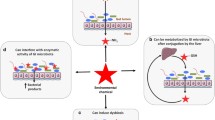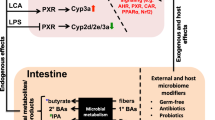Abstract
The gastrointestinal tract forms the first line of defense in the body against the main load of xenobiotics. The gastrointestinal mucosa has several mechanisms through which the xenobiotics are modified. The monooxygenase activities in most species are relatively low in the mucosa as compared to the liver, but conjugation, for example, via glucuronide formation proceeds efficiently. UDP-glucuronosyltransferase activities can exceed those in the liver. Glutathione S-transferase activity is also high. The biotransformation activities are readily inducible in the mucosa and this is, at least partly, responsible for the oral-aboral gradient seen in enzyme activities. In rainbow trout glutathione S-transferase is, however, significantly higher at the aboral third than in two oral segments, although in rats the intestinal glutathione S-transferase shows a clear oral-aboral gradient. The gradient is independent of the presence of microflora at least in the case of carboxylesterase and glutathione S-transferase. A similar gradient can also be found from the gut lumen, in both germ-free and specific pathogen-free rats. The cells in the middle of the villi appear to be most responsive under the influence of inducers. The readily occurring induction in the mucosa provides a suitable model for studies on biological effects to defined compounds and mixtures.
Similar content being viewed by others
References
Abrams GP, Bauer H, Sprinz H (1963) Influence of the normal microbial flora on mucosal morphology and cellular renewal in the ileum. Lab Invest 12: 355–364
Aitio A (1973) Extrahepatic microsomal drug metabolism. Thesis, University of Turku, Finland
Borgström B, Dahlquist A, Gustafsson BE, Lundh G, Malmquist J (1959) Trypsin, invertase and amylase content of faeces of germ free rats. Proc Soc Exp Biol Med 102: 154–155
Borgström A, Genell S, Ohlsson K (1977) Endogenous elevated fecal levels of pancreatic endopeptidases after antibiotic treatment. Scand J Gastroenterol 12: 525–529
Drasaer BS, Hill MJ (1974) Human intestinal flora. Academic Press, London, New York, San Francisco, pp 53–168
Hänninen O, Aitio A (1968) Enhanced glucuronide formation in different tissues following drug administration. Biochem Pharmacol 17:2307–2311
Hänninen O, Mackenzie P, Toivonen L (1980) Muscosal biotransformation and metabolic gradients in the intestine. In: Mozsik Gy, Hänninen O, Javor T (eds) Gastrointestinal defence mechanisms. Adv Physiol Sci, vol 29. Pergamon Press and Akademiai Kiado, Budapest, pp 353–372
Hamilton JD, Dawson AM, Webb J (1967) Limitations of the use of inert gases in the measurement of small gut mucosal blood flow. Gut 8: 509–521
Hayes JD, Chalmers J (1983) Bile acid inhibition of basic and neutral glutathione S-transferases in rat liver. Biochem J 215: 581–588
Hietanen E (1985) Tissue-specificity of extrahepatic monooxygenases in the metabolism of xenobiotics. In: Scist G (ed) Drug metabolism. Molecular approaches and pharmacological implications. Pergamon Press, pp 141–146
Hietanen E, Hänninen O (1972) Effect of chyme on mucosal enzyme levels in the small intestine of the rat. Metabolism 21: 991–1000
Hoensch H, Woo CH, Raffin SB, Schmid R (1976) Oxidative metabolism of foreign compounds in rat small intestine: Cellular localization and dependence on dietary iron. Gastroenterology 70: 1063–1070
Ichihara K, Ichihara K, Kaku M, Ogita K, Yamamoto S, Kusunose M (1983) Separation of two forms of cytochrome P-450 with aryl hydrocarbon hydroxylase activity from intestinal mucosa microsomes of rabbits treated with 3-methylcholanthrene. Biochem Int 7: 179–186
Jones DP, Grafström R, Orrenius S (1980) Quantitation of hemoproteins in rat small intestinal mucosa with identification of mitochondrial cytochrome P-450. J Biol Chem 255: 2382–2390
Kivelä-Ikonen P, Hänninen O, Kalliokoski P, Koivusaari U (1983) Influence of fly ash charcoal on the inducer activity of benzo(a)pyrene and smoke condensate in the gut mucosa of the rat. Environ Res 32: 1–7
Koivusaari U (1984) Xenobiotic transformation in rainbow trout, Salmo gairdneri, with special reference to seasons and reproduction. Thesis, University of Kuopio, Finland
Koster AS, Noordshoek J (1983) Glucuronidation in isolated perfused rat intestinal segments after mucosal and second administration of 1-naphthol. J Pharmacol Exp Ther 226: 533–538
Lepkowsky S, Wagner M, Furuta F, Ozone K, Koike T (1964) The proteases, amylase and lipase of the intestinal contents of germfree and conventional chickens. Poultry Sci 43: 722–726
Lindström-Seppä P, Koivusaari U, Hänninen O (1981a) Metabolism of xenobiotics by vendace (Coregonus albula). Comp Biochem Physiol 68c: 121–126
Lindström-Seppä P, Koivusaari U, Hänninen O (1981b) Extrahepatic xenobiotic metabolism in North-european freshwater fish. Comp Biochem Physiol 69c: 259–263
Pelkonen KHO, Havighorst E, Halonen T, Hänninen O (1981) Fecal excretion of digitonin metabolites in germfree (GF) and concentional (CV) rats. In: Moszik Gy, Hänninen O, Javor T (eds) Gastrointestinal defence mechanisms. Adv Physiol Sci, vol 29. Pergamon Press and Academiai Kiado, Budapest, pp 567–573
Rolls BA, Turvey A, Coates ME (1978) The influence of the gut microflora and dietary fibre on epithelia cell migration in the chick intestine Br J Nutr 39: 91–98
Rod TO, Midtvedt T (1977) Origin of intestinal glucuronidase in germfree, monocontaminated and conventional rats. Acta Microbiol Scand B 85: 271–276
Salter DN (1984) Nitrogen metabolism. In: Coates M, Gustafsson B (eds) The germ-free animal in biomedical research. Laboratory Animals, London, pp 235–263
Schwarz LR, Schwenk M (1984) Sulfation in isolated enterozytes of guinea pig: dependence on inorganic sulfate. Biochem Pharmacol 33: 3353–3356
Schwenk M, Locher M (1985) 1-Naphtol conjugation in isolated cells from liver, jejunum, ileum, colon and kidney of the guinea pig. Biochem Pharmacol 34: 679–701
Simon GL, Gorbach SL (1981) Intestinal flora in Health and Diagnose. In: Johnson RL (ed) Physiology of gastrointestinal Tract, vol 2. Raven Press, New York, pp 1361–1380
Wattenberg LW, Leong JL, Strand PJ (1962) Benzpyrene hydroxylase activity in the gastrointestinal tract. Cancer 22: 1120–1125
Author information
Authors and Affiliations
Additional information
Dedicated to Professor Dr. med. Herbert Remmer on the occasion of this 65th birthday
Rights and permissions
About this article
Cite this article
Hänninen, O., Lindström-Seppä, P. & Pelkonen, K. Role of gut in xenobiotic metabolism. Arch Toxicol 60, 34–36 (1987). https://doi.org/10.1007/BF00296943
Issue Date:
DOI: https://doi.org/10.1007/BF00296943




